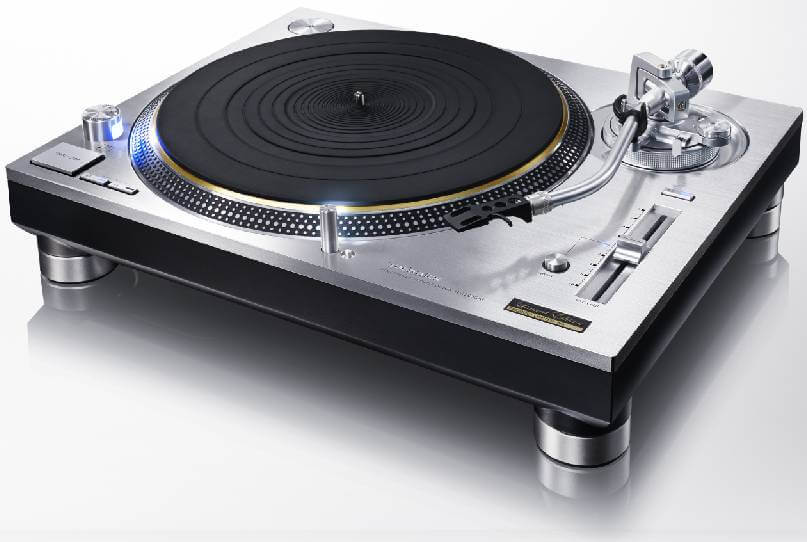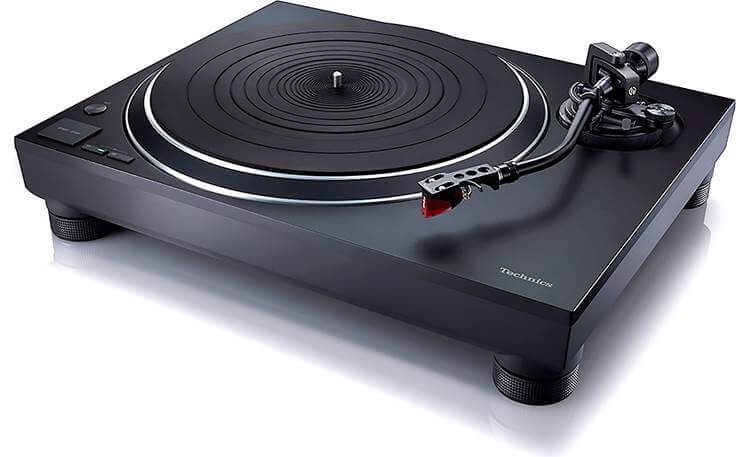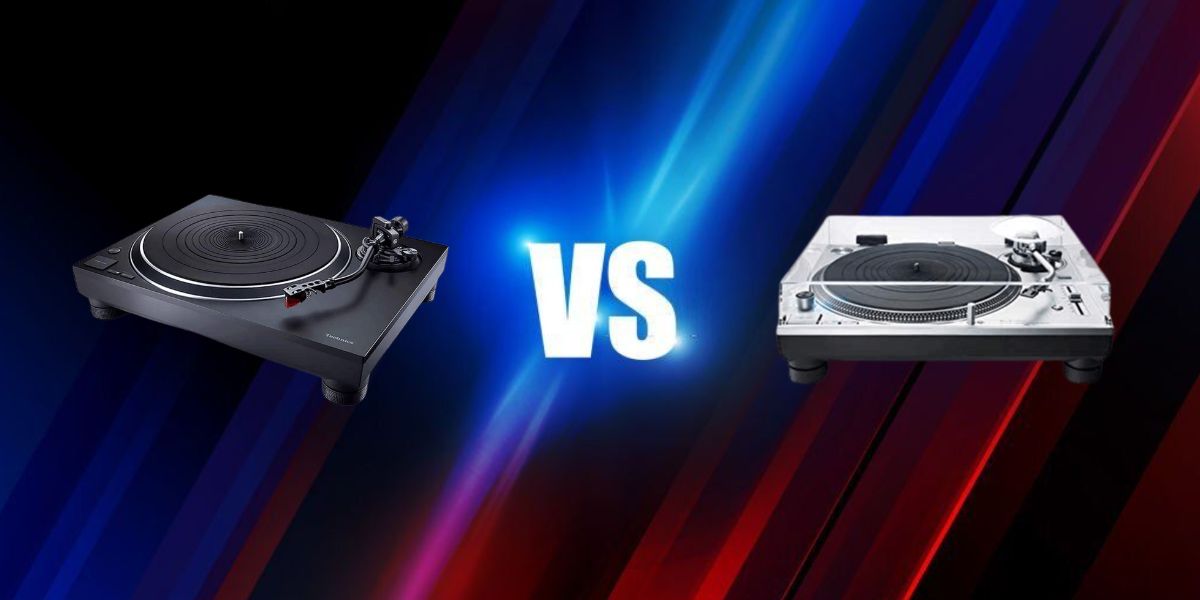Comparing one or more items can be a little frustrating, especially with all the biased and affiliate websites out there. The comparison becomes even more frustrating when you compare electronics that you don’t fully understand yet.
Turntables are good examples of electronics we use without understanding what’s happening. This article may have popped into your feed if you have already narrowed it down to two close competitors.
Our two close competitors today are two Technics turn tables, Technics SL-1500C vs. SL-1200GR, specifically.
Technics SL-1500C vs. SL-1200GR: Overview
SL-1200GR is more heavy-duty with a heavier platter and chassis. It also features an adjustable pitch fader that can change the speed by +/-16%.
This pitch fader may not be necessary if you’re just aiming to listen and chill. However, if you’re into mixing music and loving those DJ effects, the pitch fader will give you a treat.
SL-1500C, on the other hand, automatically lifts the tonearm off the record when done. This is useful if you don’t want to bother resetting the tonearm yourself.
In short, 1500C is good if you want a high-quality turntable for home usage. On the other hand, 1200GR suits those who like different effects.
What is Technics SL-1500C?
The Technics SL-1500C is a direct drive turntable system. It descends directly from the Technics SL-1200GR with the same gimbal suspension construction and single-rotor coreless direct-drive motor.
A direct drive system is when the driving motor is located directly below the spinning metal platter. This provides high torque and consistent spinning speeds.
What is Technics SL-1200GR?
The SL-1200GR is a turntable that’s robust enough to be used by professionals and simple enough to be used by amateurs at home.
It features the same direct drive concept found in the 1500C. However, the motor is also coreless. A coreless motor provides better efficiency than a regular motor as it takes less force to rotate.
As a result, the turntable speeds up and decelerates faster.
Similarities Between Technics SL-1500C and SL-1200GR

Before placing the SL-1500C and the SL-1200GR in our little comparison, let’s first understand what they both do equally well.
The Motor
Turntables, in general, suffered for a long time from unreliable motors. These motors cause stutters and slow rotation speeds, which Technics’ popularity mainly appeared because of their consistent motors.
Luckily. both SL-1500C and SL-1200GR use this improved direct drive motor.
Additionally, the motor controls its speed using a generated sine wave signal. With the recent improvement in the microprocessor power, the sine wave has become purer, providing a far more consistent speed.
Users also read: Technics SU-G700 Vs Yamaha A-S1200
Platter Design
Platter design is another aspect where the SL-1500C and SL-1200GR agree. This is because both models are built via a two-layer construction method.
Although very consistent, direct drive motors tend to produce vibrations that some ears may find unpleasant. The two-layer design aims primarily to tackle that issue.
The first layer, or the primary platter, is made from reinforced, high-quality aluminum. This material is relatively heavy to minimize the vibrations that may arise from the direct drive motor.
The second layer is the rubber material or mat you find above the primary layer. That rubber damping is designed to reduce the vibrations even more before they reach your record.
Tonearm
The tonearm of both the SL-1200GR and SL-1500C is essentially the same. The two models feature the classic S-shaped tonearm with a removable headshell.
The tonearm’s primary purpose is to guide the needle on the vinyl. Therefore, it should be rigid enough to keep the needle in place and lightweight enough to prevent the needle from scratching the vinyl.
The tonearms of both models are made of lightweight, rigid aluminum. That aluminum is fixed on a flexible gimbal that allows those micro-movements of the tonearm as the record spins.
The Differences Between Technics SL-1500C and SL-1200GR
Now that we know how the SL-1500C and SL-1200GR agree, it’s time to understand where they disagree.
Isolation Feet
Isolation feet are the little knobs or feet that the turntable rests on. Those feet should prevent vibrations of the turntable from reaching the surface underneath and vice versa.
You wouldn’t want your turntable to vibrate your desk, and you don’t want any vibration on your desk to affect the quality of the music. Some models even allow you to adjust the height of the isolation feet.
Luckily, Both the SL-1500C and SL-1200GR allow you to adjust the height of the isolation feet. However, they’re not made from the same material.
SL-1500C feet incorporate some coil springs in their feet, similar to a car’s suspension system. They’re very basic but quite effective in vibration isolation.
SL-1200GR also uses coil springs but with a few extra additions. It goes the extra mile by adding cylindrical tubes and microcell polymers, reducing vibrations even more.
In short, SL-1200C isolation feet are designed to withstand the extra load, like when you manually rotate the vinyl to get additional DJ effects.
Turntable Chassis
A good-quality turntable chassis should be heavy enough to withstand the impacts and rotation speeds of the records.
SL-1200GR utilizes a mixture between aluminum and BMC (bulk modeling compound) to give you a heavy chassis of about 25.3 lbs.
SL-1500C also uses aluminum, but it mixes it with different materials, ABS (acrylonitrile butadiene styrene) to be specific. The resulting chassis weighs 21.2 pounds, a little lighter than the 1200GR chassis.
The weight difference is minimal, but it still favors the 1200GR. After all, it’s made for DJ purposes.
Regarding color, both models come in silver or black. The difference is that you can also opt for a black tonearm in the SL-1500C.
Platter Weight
Like the chassis, the only difference in the platter between the two models lies in its weight.
The platter of the SL-1200GR is a bit heavier. It weighs roughly 5.51 lbs, compared to the SL-1500C 4.5 lbs platter.
With an extra pound, the mass of the SL-1200GR is about 20% heavier than that of the SL-1500C. As a result, you get some audio enhancement as the needle tracks the record grooves a bit better.
Speed Control
There’s a considerable difference in this respect. However, most people won’t mind that difference as the sound quality impact is negligible.
SL-1500C allows you to select a rotation speed of 33 rpm or 45 rpm. However, if you press the buttons of both speeds together, you get a 78 rpm, which some people desire.
On the other hand, SL-1200GR offers a pitch fader. This fader allows you to slightly increase or decrease the rotation speed in the platter instead of selecting a fixed speed.
To be more specific, you can increase or decrease the rotation speed by 16%.
Adjustable Vertical Tracking Angle

The vertical tracking angle or VTA is how high is the back of the tonearm. When you can adjust the VTA, you’ll have more control over your sound quality.
For example, if you reduce the VTA, you force the needle deeper into the vinyl grooves, allowing it to read the tracks better and, thus, better quality music.
However, that’s not always recommended since it may damage the needle and the record. Instead, it’s best to parallel the cartridge’s top with the record’s surface.
Both the 1500C and the 1200GR allow you to adjust the VTA. However, the latter allows you to adjust as the record plays, which is something that the 1500C can’t do.
Related: MoFi Studiodeck vs. Rega Planar 3
Connections and Cables
Both models have RCA jacks at their backs if you need to use a tonearm cable. However, the difference is in the material quality of the cable.
The SL-1200GR provides a better quality cable. The connections are also shielded and gold-plated to reduce wear and tear.
Warranty
Both products come with parts and a labor warranty. However, the warranty of the SL-1500C covers parts and labor for 2 years, while the one with the SL-1200GR is for 3 years.
What’s Better About Technics SL-1500C?
Perhaps, the most appealing feature of the SL-1500C is its ability to automatically life up the arm off the record surface when it ends.
This feature comes in handy while listening at home. It’s like watching a movie on TV, and then the TV shuts down on its own when the movie ends. It’s a little detail but appreciated nevertheless.
What’s Better About Technics SL-1200GR?
With a more heavy-duty chassis and stronger isolation feet, the SL-1200GR offers a clearer sound, especially at louder levels. Plus, if you put your table close enough to the speakers, it can offer reduced resonance.
Generally speaking, most DJs like this model’s fast start and stop as the SL-1200GR has braking and torque adjustments on its inner chassis that can be set without removing the platter.
Who Should Get Technics SL-1500C?
The SL-1500C is for home use. It combines the sturdiness and beauty of the design. The sound quality is also as good as it gets on a turntable.
You may not get the extra sound mixing goodies you may find on the 1200GR, but it shouldn’t matter much at home. There’s no need to have a race car on a backstreet where you can barely walk.
Who Should Get Technics SL-1200GR?
The SL-1200GR is right for both DJs and audiophiles. Whether you play DJ at home or in a more professional venue, this model offers you all the right features and tools.
Not only is the SL-1200GR fast and sturdy, but it also provides a high-quality sound.

